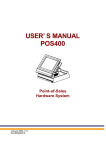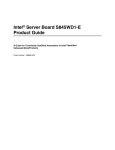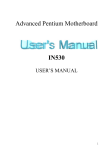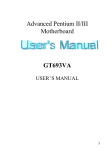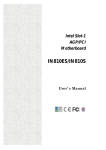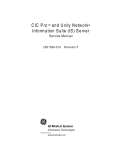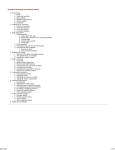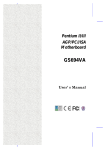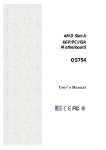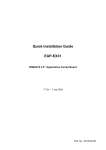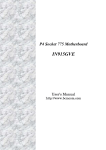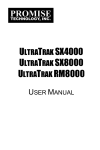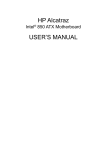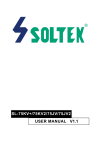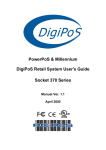Download User`s Manual - BCM Advanced Research
Transcript
Advanced Socket 370 Motherboard ED440BX User’s Manual Declaration D e c l ara tio n Rights: No part of this manual, including but not limited to the products and software described in it, may be reproduced, transmitted, transcribes, stored in a retrieval system, or translated in any form or by any means without the expressed written permission of the manufacture. Products and corporate names appearing in this manual may or may not be registered trademarks or copyrights of their respective companies and are used only for identification or explanation purposes without intent to infringe. l Intel, MMX and Pentium are registered trademarks of Intel Corporation. l IBM and OS/2 are registered trademarks of International Business Machines. l Award is a registered trademark of Award Software Inc. Responsibility: This manual is provided “As is” with no warranties of any kind, either expressed or implied, including, but not limited to the implied warranties or conditions of this product’s fitness for any particular purpose. In no event shall we be liable for any loss of profits, loss of business, loss of data, interruption of business, or indirect, special, incidental, or consequential damages of any kind, even the possibility of such damages arising from any defect or error in this manual or product. We reserve the right to modify and update the user manual without prior notice. Warning: Replace your system's CMOS RAM battery only with the identical CR-2032 3V Lithium Ion coin cell (or equivalent) battery type, to avoid risk of personal injury or physical damage to your equipment. Always dispose of used batteries according to the manufacturer's instructions, or as required by local ordinance (where applicable). 03/2001 2 Compliance & Certificate Co m p li anc e & C e r t ific a te ISO 9002 Certificate: This device was produced in our plant with advanced quality system certified by DNV QA Ltd. in according to ISO 9002. This Certificate is valid for: DESIGN & MANUFACTURE OF MOTHE BOARDS AND PERSONAL COMPUTERS. CE Declaration: CE marking is a visible declaration by the manufacturer or his authorized representatives that the electrical equipment to which it relates satisfies all the provisions of the 1994 Regulations. FCC Compliance: FCC stands for Federal Communications Commission. This product complies with FCC Rules Part 15 and has been tested, and complied with the EMI rules by a certified body. In normal operation, there shall be no harmful interference caused by this device nor shall this devise accept any interference received, including interference that may cause undesired operation of this product. . 3 Easy Installation Ea s y In s t a l l a t i o n Easy Installation Steps The following “Easy Installation” steps are for users accustomed to the assembly of a computer system. For those individuals requiring more specific information, please refer to the more detailed descriptions located within the latter chapters of this manual. Note: You must keep your power cable unplugged until the following installation steps are completed. Getting Start Touch a grounded metal surface to release static electricity stored in your body before unpacking your motherboard. For details please refer to Precaution section in Chapter 3. ! Release Static Electricity Install the CPU by correctly aligning the CPU with the socket 370 as noted in the motherboard diagram. Once aligned, press down on the CPU gently but firmly and lock it. Next, install the 3.3 volt un-buffered SDRAM into the 168 pin DIMMs. See Sec. Sec. 3.4. After completing the above steps, install any expansion Cards (PCI, AMR) into riser card and have the riser card installed firmly into the slot for riser card on board. See Sec. 3.5. Plug in all cables included in the package except for the power cord. Please see Sec. 3.6. Please recheck all steps to ensure no mistakes have been made and then plug in the power cord and turn on the power to enter the BIOS setup, Chapter 4. Insert CPU & RAM Set Jumpers of CPU Install All Expansion Slots ! 4 Couple Connectors of HDD, FDD,... 2. Features Declaration ......................................................................................................... 2 Compliance & Certificate ................................................................................... 3 Easy Installation................................................................................................. 4 Introduction........................................................................................................ 8 1.1 How To Use This Manual ............................................................................ 8 1.2 Check Your Device Items............................................................................ 8 2. Features .......................................................................................................... 9 2.1 Features Of The Motherboard ..................................................................... 9 3. Installation.....................................................................................................11 3.1 Motherboard Layout & Main Parts ..............................................................11 3.2 Slots And Connectors.................................................................................14 3.3 CPU (Central Processing Unit) ...................................................................14 3.3.1 Install CPU ...........................................................................................15 3.4 System Memory (DRAM) ...........................................................................16 3.4.1 DIMM (Dual Inline Memory Module)......................................................16 3.4.2 Installation Procedure...........................................................................16 3.4.3 DIMM Module Combinations.................................................................17 3.5 Expansion Slot ...........................................................................................18 3.6 Connectors.................................................................................................19 3.6.1 Primary IDE Connector (J20, 39-pin block, Black) ................................19 3.6.2 Secondary IDE Connector (J21, 39-pin block, White) ...........................19 3.6.3 Floppy Drive Connector (J26, 33-pin block) ..........................................20 3.6.4 Power Input Connector (J24, 20-pin block) ...........................................21 3.6.5 Front Panel connectors (J15, 20-pin)....................................................22 3.6.6 Back Panel Connectors ........................................................................23 3.6.7 Additional Connectors ..........................................................................27 4. BIOS Setup ....................................................................................................30 4.1 BIOS Setup................................................................................................30 4.1.1 Setup Keys ..........................................................................................30 4.1.2 Getting Help .........................................................................................30 4.2 Main Setup Menu .......................................................................................31 4.3 Standard CMOS Features Menu ................................................................32 4.3.1 Date .....................................................................................................32 4.3.2 Time.....................................................................................................32 4.3.3 Hard Disks ...........................................................................................33 4.3.4 Drive A/B and Floppy 3 Mode Support..................................................34 4.3.5 Video ...................................................................................................34 5 2. Features 4.3.6 Halt on .................................................................................................34 4.3.7 Memory................................................................................................35 4.4 Advanced BIOS Features Menu .................................................................35 4.4.1 Virus Warning ......................................................................................35 4.4.2 Processor Number Feature ..................................................................36 4.4.3 ATA 100 chipset...................................................................................36 4.4.4 First Boot Device..................................................................................36 4.4.5 Second Boot Device.............................................................................36 4.4.6 Third Boot Device.................................................................................36 4.4.7 Security Option ....................................................................................36 4.4.8 OS Select for DRAM > 64MB ...............................................................36 4.5 Advanced Chipset Features Menu..............................................................37 4.5.1 DRAM Data Integrity Mode...................................................................37 4.5.2 Memory Hole At 15-16M.......................................................................37 4.5.3 AGP Graphics Aperture Size ................................................................37 4.6 Integrated Peripherals ................................................................................38 4.6.1 On-Chip Primary PCI IDE .....................................................................38 4.6.2 On-Chip Secondary PCI IDE ................................................................38 4.6.3 USB Keyboard Support ........................................................................38 4.6.4 Init Display First....................................................................................38 4.6.5 Onboard FDC Controller.......................................................................38 4.6.6 Onboard Serial Port 1...........................................................................39 4.6.7 Onboard Serial Port 2...........................................................................39 4.6.8 Onboard Parallel Port ...........................................................................39 4.6.9 Parallel Port Mode................................................................................39 4.6.10 ECP Mode Use DMA..........................................................................39 4.7 Power Management Setup Menu ...............................................................40 4.7.1 ACPI function .......................................................................................40 4.7.2 Power Management .............................................................................40 4.7.2.1 PM Timers ...............................................................................................41 4.7.3 Video Off Method .................................................................................41 4.7.4 Video Off After .....................................................................................41 4.7.5 MODEM Use IRQ.................................................................................41 4.7.6 Doze Mode...........................................................................................41 4.7.7 Standby Mode......................................................................................41 4.7.8 Suspend Mode .....................................................................................41 4.7.9 VGA Active Monitor..............................................................................41 4.7.10 PowerOn by Ring ...............................................................................42 4.7.11 Resume by Alarm...............................................................................42 4.7.12 Date(of Month) Alarm .........................................................................42 4.7.13 Time (Hour) Alarm..............................................................................42 6 2. Features 4.7.14 Time(Min.) Alarm................................................................................42 4.7.15 Wake Up On LAN...............................................................................42 4.7.16 IRQ[3-7,8-15],NMI ..............................................................................42 4.7.17 Primary IDE 0.....................................................................................42 4.7.18 Primary IDE 1.....................................................................................42 4.7.19 Secondary IDE 0 ................................................................................42 4.7.20 Secondary IDE 1 ................................................................................42 4.7.21 Floppy Disk ........................................................................................42 4.7.22 Serial Port ..........................................................................................42 4.8 PnP/PCI Configurations Menu....................................................................43 4.8.1 PNP OS Installed .................................................................................43 4.8.2 Reset Configuration Data .....................................................................43 4.8.3 Resources Controlled By......................................................................43 4.9 PC Health Status........................................................................................44 4.9.1 Case Open Warning.............................................................................44 4.9.2 CPU Warning Temperature ..................................................................44 4.9.3 Current System Temp ..........................................................................44 4.9.4 Current CPU1 Temperature..................................................................44 4.9.5 Current CPUFAN1 Speed ....................................................................44 4.9.6 Current CPUFAN2 Speed ....................................................................44 4.9.7 IN0(V) ..................................................................................................45 4.9.8 IN1(V) ..................................................................................................45 4.9.9 IN2(V) ..................................................................................................45 4.9.10 +5V ....................................................................................................45 4.9.11 +12V ..................................................................................................45 4.9.12 –12V ..................................................................................................45 4.9.13 –5V ....................................................................................................45 4.9.14 VBAT(V).............................................................................................45 4.9.15 Warning_Beep ...................................................................................45 4.10 Load Fail-Safe Defaults............................................................................45 4.11 Load Optimized Defaults ..........................................................................45 4.12 Change Supervisor Password...................................................................46 4.13 Set User Password ...................................................................................46 4.14 Save & Exit Setup....................................................................................46 4.15 Exit Without Saving .................................................................................46 5. Troubleshooting ...........................................................................................47 5.1 General Troubleshooting Tips ....................................................................47 7 2. Features In t r o d u c t i o n 1.1 How To Use This Manual This manual provides information necessary for Original Equipment Manufactures (OEMs) and home users to build a PC-AT compatible system using Intel Socket 370 CPU AGP/PCI/DFP motherboard. Follow the installation procedure presented on the Easy Installation Page and refer to the section number following each step if you require more detailed instructions. USER MANUAL 1.2 Check Your Device Items The standard package should contain the following items. If you find any of these items be missing or damaged, please contact your retailer. Ø 1 ED440BX motherboard Ø 1 CD with drivers for ED440BX motherboard Ø 1 Quick-Start guide CHECK Ø 1 Data ribbon cables (Optional 8 ITEMS 2. Features 2 . Fe a t u r e s 2.1 Features Of The Motherboard This product is based on the “ ATX” form factor. It features the advanced Multimedia function and provides support for business PC maker. This motherboard incorporates Intel 82440BX AGP/PCI/ISA chipset and Promise Raid IDE Bus Controller. Ø CPU: CPU speed/voltage support may be dependant upon motherboard/BIOS revision 533MHz-1GHz (100FSB) Intel Celeron and Pentium III FC-PGA Intel Socket 370 for CPU Ø System Chipset: Intel 82440BX AGP/PCI/ISA Chipset, PIIX4 Winbond super W83977EF/CTF 100/66 MHz Bus speed Ø Cache Memory: Integrated on-die 32KB (L1) and 128KB/256KB(L2) cache on CPU. Ø Graphics Support: ATI Rage XL 2x AGP controller with 230MHz RAMDAC Desktop display modes up to 1600x1200x16 bpp colors. (4MB video RAM) 1 VGA DB15 output ports 4 SDRAM Display Memory Ø Onboard Promise PCI ATA-100/66/33, RAID controller: Promise PDC20267 PCI ATA-100/66/33 RAID controller Support 2 IDE ATA-100/66/33 connectors. (Up to 4 devices) Support RAID, Hot Swap function Ø Dual Intel 82559 LAN Controllers: Onboard Dual LAN Intel 82559 PCI LAN controllers Support IEEE 802.3 10BASE-T and 100BASE-TX Advance ACPI, WFM 2.0, Intel LDCM support AOL-II support. (Optional) 9 2. Features Ø System Memory: 4 DIMM sockets support up to 1GB using 16/64/128/256Mb technology Supports up to 4 double-sided DIMMs at 100 MHz (133 optional) memory bus Un-buffered, NON-ECC / ECC DIMM support Ø On Board PCI IDE: 2 X PCI Bus Master IDE Ports (Up to 4 IDE Devices) Support PIO Mode 0, 1, 2, 3 Supports Enhanced IDE PIO mode 3 and 4, 17MB/sec. (Max) Support UDMA Mode 33MB/sec. (Max) Ø On Board I/O: 1 Floppy Port (up to 2.88 MB) 1 Parallel Port (ECP, EPP) 2 Serial Ports (16C550 Fast UART Compatible) with FIFO's, Plug & Play 1 PS/2 Keyboard connector 1 PS/2 Mouse connector 2 Standard USB Ports (48MHz) Supports up to 127 USB Devices Winbond hardware monitor W83782D 4 Fan connectors (2 has speed monitoring) 9 Voltage inputs 1 Chassis Open Monitor 2 Thermal inputs Ø Additional Features: ACPI 1.0a, LDCM, WFM2.0 compliant Keyboard/Mouse/USB wake up Wake-on-LAN, Wake-on-Ring PCI 2.1 compliant PME# and 3.3VAux signals to support power management DOC (Disk-On-Chip) support Ø BIOS: 4M-bit Flash EEPROM Award PCI BIOS with Green and PnP Function, ACPI, APM, Y2K, PC99 and DMI support Ø Expansion Slots: 1 PCI/ATX Riser slot. (Up to support 1 Full-length and 1 Low Profile 32 bits PCI BUS mastering cards) Ø Form Factor: Micro-ATX form factor Board size: 9.6" x 10.1" 10 Installation 3. Installation 3.1 Motherboard Layout & Main Parts 11 Installation Connectors List Front Panel Connectors Reset LAN LED HDD LED Power Switch Power LED Speaker Refer to Sec. 3.6.6 Refer to Sec. 3.6.6 Refer to Sec. 3.6.6 Refer to Sec. 3.6.6 Refer to Sec. 3.6.6 Refer to Sec. 3.6.6 Back Panel Connectors PS/2-style keyboard and mouse connectors USB connectors Parallel port VGA port Serial port Refer to Sec. 3.6.7 Refer to Sec. 3.6.7 Refer to Sec. 3.6.7 Refer to Sec. 3.6.7 Refer to Sec. 3.6.7 Expansion Slots/Sockets CPU Socket DIMM Sockets Expansion Slot Refer to Sec. 3.3 Refer to Sec. 3.4 Refer to Sec. 3.5 Power/IDE/FDD Connectors IDE connectors Power connector FDD connector Refer to Sec. 3.6.1 – 3.6.2 Refer to Sec. 3.6.4 Refer to Sec. 3.6.3 Additional Connectors Front USB Header CLR PWD/CMOS Chassis Intrusion WOL Connector CPU Fan Refer to Sec. 3.6.8 Refer to Sec. 3.6.8 Refer to Sec. 3.6.8 Refer to Sec. 3.6.8 Refer to Sec. 3.6.8 12 Installation Precaution Before Start Static Electricity Damage: Static electricity can easily damage your motherboard. Observing a few basic precautions can help safeguard against damage that could result in expensive repairs. Follow the simple measures below to protect your equipment from static electricity damage. 1. Keep the motherboard and other system components in their anti-static packaging until you are ready to install them. 2. Touch a grounded surface before you remove any system component from its protective anti-static packaging. Unpacking and installation should be done on a grounded, anti-static mat. The operator should be wearing an anti-static wristband, grounded at the same points as the anti-static mat. 3. After removing the motherboard from its original packaging, only place it on a grounded, anti-static surface component side up. Immediately inspect the board for damage. Due to shifting during shipping, it is suggested that the installer press down on the entire socket ICs to ensure they are properly seated. Do this only with the board placed on a firm flat surface. 4. During configuration and installation touch a grounded surface frequently to discharge any static electrical charge that may have built up in your body. The best precaution is to wear a grounded wrist strap. Avoid touching the components When handling the motherboard or an adapter card. Handle the motherboard and adapter cards either by the edges or by the adapter card case-mounting bracket. Misplaced Jumper Damage: There are critical headers used for connectors or power sources. These are clearly marked separately from the jumpers listed in Motherboard Layout. Incorrect setting jumpers and connectors may lead to damage to your motherboard. Please pay special attention not to connect these headers in wrong directions 13 Installation 3.2 Slots And Connectors This motherboard requires jumper setting for some features. The following graphic shows you how to set a proper jumper setting. PIN 1 PIN 1 Note: In the following pages, the triangle s mark stands for pin 1 of connectors. 3.3 CPU (Central Processing Unit) This motherboard supports a PGA 370 Intel Celeron/Coppermine PGA family processor. To complete CPU installation, please install CPU to socket firmly, presented in sec. 3.2.1. 14 Installation 3.3.1 Install CPU Please follow the below steps to install your CPU, and configure the types and speed in accordingly to the Processor Jumper Setting List. Step 1: Pull the handling bar of the socket upward to the other end to loosen the socket’s openings. Step 2: Place the CPU on the middle of the socket, orienting its beveled corner to line up with the socket’s beveled corner. Make sure the pins of the CPU fit evenly to the socket openings. Handling Bar Step 3:Press the handling bar downward to fasten the CPU to the socket. Warning: It is strongly recommended that a heatsink and CPU cooling fan be used to prevent the CPU from overheating. Applying a thermal jelly between the CPU and the heatsink/fan will further cool the CPU. 15 Installation 3.4 System Memory (DRAM) 3.4.1 DIMM (Dual Inline Memory Module) The motherboard features four 168-pin DIMM sockets, share memory module. If you have only one DIMM RAM, note that you must insert it into DIMM 1. You can configure the system memory size from 8MB to 512MB in a variety of ways by using different combinations of the two 168-pin DIMM. DIMM Slots 3.4.2 Installation Procedure Step1: Make sure Pin 1 of the DIMM match with pin 1 of the DIMM socket. Step2: Insert the DIMM module into the DIMM socket vertically. After inserting the DIMM module completely into the socket, push up on the socket latches securing the DIMM into place. 16 Installation If the pin 1 of the DIMM module does not line up with pin 1 of the socket, the DIMM module will not be inserted correctly into the socket. Be careful not to misfit the DIMM Module into DIMM sockets in wrong direction. This module can be inserted into the socket only one way. To release the memory module, push both latches down and carefully rock the module forward and backward while slowly lifting it upward. 3.4.3 DIMM Module Combinations Each DIMM socket can be inserted with 8MB, 16MB, 32MB, 64MB, 128MB and 256MB DIMM. For example, the following figure shows you one way to insert your DIMM. DIMM 1 DIMM 2 DIMM 3 DIMM4 Select DIMM 1:128MB DIMM 2:128MB DIMM 3:64MB DIMM 4:64MB Total 128+128+64+64=384 Select 1 out of 7 Choices (empty, 8MB, 16MB, 32MB, 64MB, 128MB, 256MB) in DIMM1. Then, repeat again in DIMM2 through DIMM 3 and 4 for 7 choices (Empty, 8 MB, 16 MB, 32 MB, 64 MB, 128MB, 256MB) to go through your own path. 17 Installation 3.5 Expansion Slot This motherboard contains 1 PCI / ATX Riser slot (Up to support 1 Full-length and 1 Low Profile 32 bit PCI BUS mastering cards). 18 Installation 3.6 Connectors This motherboard contains IDE, floppy, power input, front panel and additional connectors. Secondary IDE 2 40 1 39 2 40 39 1 Primary IDE 3.6.1 Primary IDE Connector (J20, 39-pin block, Black) This connector supports two primary channel IDE devices via a ribbon cable. When two IDE devices are installed using the primary IDE connector, make sure that the second IDE device is set to slave mode as indicated in the device’s manual. 3.6.2 Secondary IDE Connector (J21, 39-pin block, White) This connector supports two secondary channel IDE devices as well as the 120MB Floppy drives via a ribbon cable. When two IDE devices are installed using the secondary IDE connector, make sure that the second IDE device is adjusted to slave mode as indicated in the device’s manual. Warning: When you connect a ribbon cable to these ports, you must orient the cable connector so that the PIN 1 edge of the cable is at the PIN 1 edge of the onboard connector. 19 Installation 3.6.3 Floppy Drive Connector (J26, 33-pin block) 2 34 1 33 The FDC sub-system can control three types of floppy drives (1.2, 1.44 and 2.88MB) or compatible tape drives. The connection to the floppy drive is via a header (J26). The floppy disk interface includes 48mA drivers and inputs on the drive interface. 20 Installation 3.6.4 Power Input Connector (J24, 20-pin block) 11 1 20 10 This connector supports one standard ATX power supply. When connecting, make sure the lock key matches the hook attached on a power supply cable. The power cord should be unplugged when you connect it. 21 Installation 3.6.5 Front Panel connectors (J15 (J15,, 2020- pin) Power Switch, Power LED, Reset, Sleep and HDD LED. SPEAKER LAN 2 LAN 1 GRN/YEL PWR LED LED System HDD A HDD B Fault RESET LED Reset Switch Connector (2-pin) This connector supports the front panel case-mounted reset button. It is advised that the reset switch be used for rebooting the system in order to extend the life of the system’s power supply. HDD (IDE) LED Connector (2-pin) The motherboard supports two straight 2-pin headers set for connecting to front Panel Hard Disk activity LED indicator. LAN LED (2-pin) The motherboard supports two straight 2-pin headers set for connecting to front Panel Hard LAN activity LED indicator. Power/Sleep Switch (2-pin) 22 Installation This connector supports the ATX case-mounted Power Switch, which in turn supports System Suspend function. When the BIOS sets the Power Button function to “Suspend”, the system can be set to the suspended mode once you push the power switch for no longer then 4 seconds. If the power switch is pushed down for over 4 seconds the system will be totally Power Off. When this BIOS setting sets to “Instant-off”, then Power Switch function work as regular power switch. Power/Sleep LED (2-pin) This header can be connected to a 2-color LED that will light yellow or green when the computer is in “Suspend” or “Normal” operation. Speaker Connector (J19, 4-pin, Optional) It is used to drive a chassis-mounted speaker if desired. Or this header will be removed and replaced with an integrated Buzzer. 3.6.6 Back Panel Connectors 23 Installation Mouse USB2 Keyboard USB1 Printer Port COM1 VGA LAN 2 PS/2 Keyboard and Mouse Ports The motherboard offers 1 PS/2 Keyboard and 1 PS/2 Mouse port. Mouse Keyboard 24 LAN 1 Installation Universal Serial Bus (USB) Ports The motherboard has two USB connectors. USB devices provide a more convenient operating environment and improve data transferring capacity. True Plug & Play. This new bus technology will support over 127 different peripherals through a Hub. USB1 USB2 Parallel Port (Printer) The motherboard includes a parallel port (EPP/ECP compatible). The parallel port is capable of being disabled or remapped to either the secondary LPT address or the primary LPT address through BIOS if another parallel port is installed. Parallel port 25 Installation Serial Port (COM1, J5/ VGA, J1) The motherboard has two serial ports (one on rare panel, one on board). The electrical characteristics are compliant with the EIA-232-D Serial Communications Specifications. The serial ports may be remapped over other installable serial ports or disabled through the BIOS. COM1 VGA This product integrates the AGP function via a VGA port beside the COM1. The Accelerated Graphics Port (AGP or A.G.P.) is a high performance 3D graphical display applications. LAN 1(J3) and LAN 2 Ports (J4) The motherboard integrates Dual LAN port. LAN 2 / 1 Ports 26 Installation 3.6.7 Additional Connectors WOR (Wake On Ring) (J17, 2-pin) This header is used for remote wakeup of the computer through a modem. Ring-In requires an add-in modem card with remote wakeup capabilities. The remote wakeup header on the add-in modem card must be connected to the onboard RingIn header. Onboard Video Enable/Disable (JP3) Jumper 1-2 Close Enable (Default), jumper 2-3 Close Disable. Serial Port 2 Header (J18, 9-pin) Optional Serial Port 2 Header is for second Com Port addition cable connectors are optional. CLR Power/CMOS (JP2, 3-pin) This Jumper is chosen for clear CMOS Setting, you can clear password or all CMOS Setting to Default.. WOL (Wake On LAN) (J8, 3-pin) This header is used for remote wakeup of the computer through a network. WOL requires a PCI add-in network interface card (NIC) with remote wakeup capabilities. The remote wakeup header on the NIC must be connected to the onboard Wake on LAN header. For Wake on LAN, the 5-V standby line for the power supply must be capable of delivering 5V±5% at 720mA. CPU Fan (J2, 3-pin) Your Intel Processor may have an attached heatsink and Fan; this connector is for the Fan 1. Other fan header: System Fan-1(J22), System Fan-2(J27), Fan(J23) 27 Installation Ready To Turn On Power Check Again 1. Is the CPU installed exactly and firmly into the socket (Sec. 3.3)? 2. Are all the DRAM modules installed properly (Sec. 3.4)? 3. Did you insert the expansion card (VGA, Sound… etc.) already (Sec. 3.5)? Are you sure that all the connectors (described in Sec 3.6) have been connected to their variable devices (Sec. 3.6)? Yes, I have checked and assured the above steps! Now get ready to turn on your device by following the steps below. 1. 2. 3. 4. 5. 6. Mount your motherboard to the chassis frame and close the case cover. Switch off all power. Connect the power supply cord into inlet of the system case. Connect the power supply cord into an outlet of power supply. Connect Monitor signal cable to the system VGA port and the monitor power cord to power outlet. Now turn on the monitor and system power. After Power on, the power LED on the front panel of the system case will light. For ATX power supplies, the system LED will light when the ATX power switch is pressed. The system will then do a power-on-self-test, and additional messages will appear on screen. If the screen blinks or the tests stop more than 30 seconds, the system may have failed the power-on-self-test. If so, please recheck the above steps or call your retailer for assistance. 28 Installation If the power-on-self-test goes well, hold down <Del> button on the keyboard to enter BIOS Setup. Next, follow the instructions in the next chapter, BIOS SETUP. 29 BIOS SETUP 4. BIOS Setup The motherboard uses AWARD BIOS, stored in a flash EEPROM. All of the configuration information will be stored in the CMOS. 4.1 BIOS Setup The AWARD BIOS is immediately activated when you first turn on the computer. The BIOS reads system configuration information in CMOS RAM and begins the process of checking the system and configuring it through the Power-On-Self-Test (POST). When these preliminaries are finished, the BIOS seek an operation system on the data storage devices (hard drive, floppy drive, etc.). The BIOS launches the operating system and hands over control of system operation to it. To start Setup, press the <Del> key during boot-up before or while a message similar to this appears briefly at the bottom of the screen during the POST: Press <DEL> key if you want to enter SETUP If the above message disappears before you have responded and you still wish to enter Setup, reboot the system to try again by pressing the “RESET” button on the system case. You may also restart by simultaneously pressing the <CTRL>, <ALT> and <DEL> keys. 4.1.1 Setup Keys The keys below help you navigate in Setup. <↑> , <↓> <←> , <→> <ESC> <ESC> <PgUp> / <+> <PgDn> / <−> <F1> <F2> <F10> Move to previous or next item. Move to the item in the left or right hand. Main Menu – Quit and not save changes into CMOS. Other Pages – Exit current page and return to Main Menu. Increase the numeric value or make changes. Decrease the numeric value or make changes. General help. Change color from total 16 colors. Press <F2> to select color forward, Press <Shift> and <F2> to select color backward. Save all the CMOS changes, only for Main Menu . 4.1.2 Getting Help Press <F1> key to pop up a small help window that describes the appropriate keys to use, and the possible selections for each highlighted item. To exit the Help Window press <ESC> or the <F1> key again. 30 BIOS SETUP 4.2 Main Setup Menu When you enter the Award BIOS CMOS Setup Utility, a Main Menu appears on the screen. The Main Menu allows you to select from several Setup functions and two exit choices. Use the arrow keys to select among the items and press <ENTER> key to enter the sub-menu. A brief description of each highlighted selection appears at the bottom of the screen. Following is a brief summary of each Setup category. Standard CMOS Features Advanced BIOS Features Advanced Chipset Features Integrated Peripherals Power Management Setup PnP/PCI Configuration PC Health Status Load Fail-Safe Defaults Load Optimized Defaults Options in the original PC AT-compatible BIOS. Award enhanced BIOS options. Options specific to your system chipset. I/O subsystems that depend on the integrated peripherals controller in your system. Advanced Power Management (APM) options. Plug and Play standard and PCI Local Bus configuration options. Display the temperature of your CPU and system. Setup defaults that are at the minimum setting to ensure the system will boot without problem. Setup defaults that are factory settings for optimal performance system operations. 31 BIOS SETUP Set Supervisor Password Set User Password Save & Exit Setup Exit Without Saving Change, set, or disable a supervisor password. The supervisor password allows complete access. Change, set, or disable an user password. The user password generally allows only power-on access. Save settings in nonvolatile CMOS RAM and exit Setup. Abandon all changes and exit Setup. 4.3 Standard CMOS Features Menu In the Standard CMOS Menu, you can set the system clock and calendar, record disk drive parameters and the video subsystem type, and select the type of errors that stop the BIOS POST. 4.3.1 Date The BIOS determines the day of the week from the other date information. This field is for information only. Press the left or right arrow key to move to the desired field (date, month, year). Press <PgUp> or <PgDn> key to increment the setting, or type the desired value into the field. 4.3.2 Time The time format is based on the 24-hour military-time clock. For example, 1 p.m. is 13:00:00. Press the left or right arrow key to move to the desired field. Press the <PgUp> or <PgDn> key to increment the setting, or type the desired value into the field. 32 BIOS SETUP 4.3.3 Hard Disks The BIOS supports up to four IDE drives. This section does not show information about other IDE devices, such as a CD-ROM drive, or about other hard drive types, such as SCSI drives. NOTE: We recommend that you select type AUTO for all drives. The BIOS can automatically detect the specifications and optimal operating mode of almost all IDE hard drives. When you select type AUTO for a hard drive, the BIOS detect its specifications during POST, every time the system boots. If you do not want to select drive type AUTO, other methods of selecting the drive type are available: 1. Match the specifications of your installed IDE hard drive(s) with the preprogrammed values for drive types 1 through 45. 2. Select USER and enter values into each drive parameter field. 3. Use the IDE HDD AUTO DECTECTION function in Setup. Here is a brief explanation of drive specifications: Ø Type: The BIOS contains a table of pre-defined drive types. Each defined drive type has a specified number of cylinders, number of heads, write precompensation factor, landing zone, and number of sectors, Drives whose specifications do not accommodate any pre-defined type are classified as type USER. Ø Size: Disk drive capacity (approximate). Note that this size is usually slightly greater than the size of a formatted disk given by a disk-checking program. Ø Cyls: Number of cylinders Ø Head: Number of heads Ø Precomp: Write pre-compensation cylinder Ø Landz: Landing zone Ø Sector: Number of sectors Ø Mode: Auto, Normal, large, or LBA Ø Auto: The BIOS automatically determines the optimal mode. Ø Normal: Maximum number of cylinders, heads, and sectors supported are 1024, 16 and 63. Ø Large: For drives that do not support LBA and have more than 1024 cylinders. Ø LBA (Logical Block Addressing): During drive accesses, the IDE controller transforms the data address described by sector, head, and cylinder number into a physical block address, significantly improving data transfer rates. For drives with greater than 1024 cylinders. 33 BIOS SETUP 4.3.4 Drive A/B and Floppy 3 Mode Support Select the correct specifications for the diskette drive(s) installed in the computer. Floppy Mode 3 Support is for LS-120 disk drives if used. None No diskette drive installed. 360K, 5.25 in 5-1/4 inch AT-type standard drive; 360-kilobyte capacity. 1.2M, 5.25 in 5-1/4 inch AT-type high-density drive; 1.2-megabyte capacity. 720K, 3.5 in 3-1/2 inch double-sided drive; 720-kilobyte capacity. 1.44M, 3.5 in 3-1/2 inch double-sided drive; 1.44-megabyte capacity. 2.88M, 3.5 in 3-1/2 inch double-sided drive; 2.88-megabyte capacity. 4.3.5 Video EGA/VGA CGA 40 CGA 80 MONO Enhanced Graphics Adapter/Video Graphics Array. For EGA, VGA, SEGA, SVGA or PGA monitor adapters. Color Graphics Adapter, power up in 40-column mode. Color Graphics Adapter, power up in 80-column mode. Monochrome adapter includes high-resolution monochrome adapters. 4.3.6 Halt on During the power-on self-test (POST), the computer stops if the BIOS detect a hardware error. You can tell the BIOS to ignore certain errors during POST and continue the boot-up process. Below are the selections: No errors All errors POST does not stop for any errors. If the BIOS detect any non-fatal error, POST stops and prompts you to take corrective action. All, But Keyboard POST does not stop for a keyboard error, but stops for all other errors. All, But Diskette POST does not stop for diskette drive errors, but stops for all other errors. All, But Disk/Key POST does not stop for a keyboard or disk error, but stops for all other errors. 34 BIOS SETUP 4.3.7 Memory RAM is the computer's working memory, where the computer stores programs and data currently being used, so they are accessible to the CPU. Modern personal computers may contain up to 64 MB, 128 MB, or more. Base Memory Typically 640 KB. Also called conventional memory. The DOS operating system and conventional applications use this area. Extended Memory Above the 1MB boundary. Early IBM personal computers could not use memory above 1 MB, but current PCs and their software can use extended memory. Total Memory System total memory is the sum of base memory, extended memory, and other memory. 4.4 Advanced BIOS Features Menu These screens (Figure 3.1 and 3.2) contain industry-standard options additional to the core PC AT BIOS. This section describes all fields offered by Award Software in this screen. Some fields may vary from those in your Setup program. Your system builder may omit or modify some fields. 4.4.1 Virus Warning When enabled, you receive a warning message if a program (specifically a virus) attempts to write to the boot sector or the partition table of the hard disk drive. You 35 BIOS SETUP should then run an anti-virus program. Keep in mind that this feature protects only the boot sector, not the entire hard drive. NOTE: Many disk diagnostic programs that access the boot sector table can trigger the virus-warning message. If you plan to run such a program, we recommend that you first disable the virus warning. 4.4.2 Processor Number Feature To enable or disable Processor Number Feature. 4.4.3 ATA 100 chipset To enable or disable the onboard Promise ATA 100 chipset detection from the BIOS. 4.4.4 First Boot Device This option sets the type of device for the first boot drives that the AMIBIOS attempts to boot from after AMIBIOS Post completes. 4.4.5 Second Boot Device This option sets the type of device for the second boot drives that the AMIBIOS attempts to boot from after AMIBIOS Post completes. 4.4.6 Third Boot Device This option sets the type of device for the third boot drives that the AMIBIOS attempts to boot from after AMIBIOS Post completes. 4.4.7 Security Option If you have set a password, select whether the password is required every time the System boots, or only when you enter Setup. 4.4.8 OS Select for DRAM > 64MB Select OS/2 only if you are running OS/2 operating system with greater than 64MB of RAM on your system. 36 BIOS SETUP 4.5 Advanced Chipset Features Menu 4.5.1 DRAM Data Integrity Mode Non-ECC or ECC. Set Non-ECC for non-ECC memory modules, otherwise set at ECC. 4.5.2 Memory Hole At 15-16M In order to improve performance, certain space in memory is reserved for ISA cards. This memory must be mapped into the memory space below 16MB. 4.5.3 AGP Graphics Aperture Size Select the size of the Accelerated Graphics Port (AGP) aperture. The aperture is a portion of the PCI memory address range dedicated for graphics memory address space. Those cycles that hit the aperture range are forwarded to the AGP without any transaction. See www.agpforum.org for AGP information. 37 BIOS SETUP 4.6 Integrated Peripherals 4.6.1 On-Chip Primary PCI IDE The chipset contains a PCI IDE interface with support for two IDE channels. Select Enabled to activate the primary IDE interface. Select Disabled to deactivate this interface. The choices are: Enabled, and Disabled. 4.6.2 On-Chip Secondary PCI IDE The chipset contains a PCI IDE interface with support for two IDE channels. Select Enabled to activate the secondary IDE interface. Select Disabled to deactivate this interface. The choices are: Enabled, and Disabled. 4.6.3 USB Keyboard Support To enable or disable USB Keyboard. 4.6.4 Init Display First To choose whether PCI or AGP video to be initialized first. The choices are: PCI Slot, or AGP. 4.6.5 Onboard FDC Controller Select Enabled if your system has a floppy disk controller (FDC) installed on the system board and you wish to use it. If you install add-in FDC or the system has no floppy drive, select Disabled in this field. The choices are: Enabled, and Disabled. 38 BIOS SETUP 4.6.6 Onboard Serial Port 1 This item allows you to determine access onboard serial port 1 controller with which I/O address. The choices are: 3F8/IRQ4, 2E8/IRQ3, 3E8/IRQ4, 2F8/IRQ3, Disabled, and Auto. 4.6.7 Onboard Serial Port 2 This item allows you to determine access onboard serial port 2 controller with which I/O address. The choices are: 3F8/IRQ4, 2E8/IRQ3, 3E8/IRQ4, 2F8/IRQ3, Disabled, and Auto. 4.6.8 Onboard Parallel Port This item allows you to determine access onboard parallel port controller with which I/O address. The choices are: 378H/IRQ7, 278H/IRQ5, 3BC/IRQ7, and Disabled. 4.6.9 Parallel Port Mode The parallel port can be used with devices that adhere to the Enhanced Parallel port (EPP) specification. EPP uses the existing parallel port signals to provide asymmetric bi-directional data transfer driven by the host device. It also can be used with devices that adhere to the Extended Capabilities Port (ECP) specification. ECP uses the DMA protocol to achieve data transfer rates up to 2.5 megabits per second. ECP provides symmetric bi-directional communication. 4.6.10 ECP Mode Use DMA Determines which DMA the ECP mode uses. 39 BIOS SETUP 4.7 Power Management Setup Menu The Power Management Setup allows you to configure your system to most effectively save energy while operating in a manner consistent with your own style of computer use. 4.7.1 ACPI function ACPI (Advanced Configuration and Power Interface) evolves the existing motherboard configuration interfaces to support these advanced architectures in a more robust, and potentially more efficient manner. 4.7.2 Power Management This option allows you to select the type (or degree) of power saving for Doze, Standby, and Suspend modes. See the section 4.7.2.1 PM Timers for a brief description of each mode. This table describes each power management mode: Max Saving User Define Min Saving Maximum power management. Only Available for SL CPUs. Doze Mode = 1 min., Standby Mode = 1 min., Suspend Mode = 1 min., and HDD Power Down = 1 min. Allows you to set each mode individually. When not disabled, each of the ranges are from 1 min. to 1 hr. except for HDD Power Down which ranges from 1 min. to 15 min. and disable. Minimum power management. Doze Mode = 1 hr., Standby Mode = 1 hr., Suspend Mode = 1 hr., and HDD Power Down = 15 min. 40 BIOS SETUP 4.7.2.1 PM Timers This category allows you to select the type (or degree) of power saving and is directly related to the following modes: 1. 2. 3. HDD Power Down – When enabled and after the set time of system inactivity, the hard disk drive will be powered down while all other devices remain active. Doze Mode – When enabled and after the set time of system inactivity, the CPU clock will run at slower speed while all other devices remain active. Suspend Mode – When enabled and after the set time of system inactivity, all devices except the CPU will be shut off. 4.7.3 Video Off Method Determines the manner in which the monitor is blanked. V/H SYNC+Blank DPMS Blank Screen System turns off vertical and horizontal synchronization ports and writes blanks to the video buffer. Select this option if your monitor supports the Display Power Management Signaling (DPMS) standard of the Video Electronics Standards Association (VESA). Use the software supplied for your video subsystem to select video power management values. System only writes blanks to the video buffer. 4.7.4 Video Off After Monitor activity after video off: Doze, N/A, Standby or Suspend. 4.7.5 MODEM Use IRQ Determines which IRQ the MODEM can use. The choices are: 3, 4, 5, 7, 9, 10, 11 and N/A. 4.7.6 Doze Mode Setup the timer to enter Doze Mode. 4.7.7 Standby Mode Setup the timer to enter Standby Mode. 4.7.8 Suspend Mode Setup the timer to enter Suspend Mode. 4.7.9 VGA Active Monitor To enable or disable VGA Active Monitor. 41 BIOS SETUP 4.7.10 PowerOn by Ring Enables or disables Power On by Ring. 4.7.11 Resume by Alarm Enables or disables alarm function to POWER ON the system. 4.7.12 Date(of Month) Alarm Select one: Everyday, 1 to 31. 4.7.13 Time (Hour) Alarm Set hh with 0-23. 4.7.14 Time(Min.) Alarm Set mm with 0-59. 4.7.15 Wake Up On LAN Enable or disable WOL feature. 4.7.16 IRQ[3-7,8-15],NMI Enable or disable IRQ Global Timer Events. 4.7.17 Primary IDE 0 Enables or disables monitor for Primary IDE 0 for Green event. 4.7.18 Primary IDE 1 Enables or disables monitor for Primary IDE 1 for Green event. 4.7.19 Secondary IDE 0 Enables or disables monitor for Secondary IDE 0 for Green event. 4.7.20 Secondary IDE 1 Enables or disables monitor for Secondary IDE 1 for Green event. 4.7.21 Floppy Disk Enables or disables monitor Floppy Disk for Green event. 4.7.22 Serial Port Enables or disables monitor Serial Port for Green event. 42 BIOS SETUP 4.8 PnP/PCI Configurations Menu 4.8.1 PNP OS Installed Select Yes if you are using a Plug and Play capable operating system, otherwise select No if you need the BIOS to configure non-boot devices. 4.8.2 Reset Configuration Data Select Enabled to reset Extended System Configuration Date (ESCD) when you exit Setup if you have installed a new add-on and the system reconfiguration has caused such a serious conflict that the operating system cannot boot. 4.8.3 Resources Controlled By The Award Plug and Play BIOS can automatically configure all the boot and Plug and Play-compatible devices. If you select Auto, all the interrupt request (IRQ) and DMA assignment fields disappear, as the BIOS automatically assign them. 43 BIOS SETUP 4.9 PC Health Status 4.9.1 Case Open Warning To warn for the case being opened without authorization, enable require a chassis with case open sensor. Otherwise, by disabling will leave no warning when a case is opened. 4.9.2 CPU Warning Temperature Shows the warning message to inform you the CPU temperature reaches the value you set if enabled. The choices are: Disabled, 50°C/122°F, 53°C/127°F, 56°C/133°F, 60°C/140°F, 63°C/145°F, 66°C/151°F, and 70°C/158°F. 4.9.3 Current System Temp The temperature here will vary according to the current system. 4.9.4 Current CPU1 Temperature The temperature here will vary according to the current CPU1. 4.9.5 Current CPUFAN1 Speed Displays current CPUFAN1 speed. The unit is RPM. 4.9.6 Current CPUFAN2 Speed Displays current CPUFAN2 speed. The unit is RPM. 44 BIOS SETUP 4.9.7 IN0(V) Displays voltage value. 4.9.8 IN1(V) Displays voltage value. 4.9.9 IN2(V) Displays voltage value. 4.9.10 +5V Displays voltage value. 4.9.11 +12V Displays voltage value. 4.9.12 –12V Displays voltage value. 4.9.13 –5V Displays voltage value. 4.9.14 VBAT(V) Displays voltage value. 4.9.15 Warning_Beep Enable or Disable CPU or system fan fail warning, beep from system buzzer. 4.10 Load Fail-Safe Defaults AWARD BIOS will automatically set all BIOS setup options to a complete set of default settings when you choose this option. The Fail-Safe settings are designed for maximum system stability, but not maximum performance. Choose the FailSafe option if your computer is experiencing system configuration problems. 4.11 Load Optimized Defaults The chipset defaults are settings, which provide for maximum system performance. While Award has designed the custom BIOS to maximize performance, the manufacturer has the right to change these defaults to meet their needs. 45 BIOS SETUP 4.12 Change Supervisor Password The BIOS setup will not be accessible unless you enter the correct password. Select “Set Supervisor Password” and press <ENTER> key, the screen will display the symbol “*” instead of characters entered. After the new password is entered, retype the new password as prompted and press <ENTER> key. If the password confirmation is incorrect, an error message appears. If the new password is entered without error, press <ESC> key. The password is stored in NVRAM after BIOS completes its cycle. Next time when booting the system, a password prompt will appear if the password function is enabled. 4.13 Set User Password When you select this function, a message appears at the center of the screen “ENTER PASSWORD”. Type the password, up to eight characters, and press <ENTER> key. Typing a password clears any previously entered password from CMOS memory. Now the message changes to “CONFIRM PASSWORD”. Again, type the password and press <ENTER> key. To abort the process at any time, press <ESC> key. In the Security Option item in the BIOS Features Setup screen select System or Setup: Ø System: Enter a password each time the system boots and whenever you enter Setup. Ø Setup: Enter a password whenever you enter Setup. NOTE: To clear the password, simply press Enter when asked to enter a password. Then the password function is disabled. 4.14 Save & Exit Setup This feature allows the changes to be made to the CMOS setup to be saved. The system will resume booting after a successful save. 4.15 Exit Without Saving Abandon all CMOS value change without saving. 46 Troubleshooting 5. Troubleshooting 5.1 General Troubleshooting Tips 1) 2) 3) Is your system properly assembled and configured? a. Make sure the BIOS setup is set to default/optimal settings. Pressing <F2> or <DEL> key to enter the setup, select Default or Optimal settings, then save and exit the setup. b. For Windows 2000 that require ACPI support, make sure the ACPI option on your BIOS is enable (Some EOL boards will not support it at all). c. Is your board jumpered according to the manual/”Jumpers” in the website? d. Is all or any of your peripherals seated properly, that includes CPU, memory, video card, etc... You may even want to try re-seating them. e. Is your power supply switched on for those have an on/off switch on the back of the power supply and plugged in. Is your power supply set for proper voltage (115 or 120 for US, 220 or 230 for Europe)? For Europe, if your power supply is set at 115 or 120 and accidentally plugged with 220 or 230 volt power outlet, your system may be already damaged, in that case, consult your vendor. f. Some problems and/or conflict can be resolved as simple as by flashing the BIOS with the latest version downloadable from our website. Is there any conflict with hardware and/or drivers? a. Make sure your BIOS setup is in default settings. b. Make sure the drivers for the installed peripherals that you have are the latest version. c. Windows may have some old lingering drivers from an old setup and/or an old motherboard you upgraded from. These older drivers may be causing problems and/or conflicts in your system. The best step is to back up your data and re-install Windows on clean drive. WARNING: Only experienced people should do this as data loss may be possible. Have you verified all of your system components for functionality? a. If you have problem running your system, and unsure of which component is at fault, please do a component inspection: i. CPU ii. Memory iii. Hard Drive iv. Video Card (if the motherboard does not equip with onboard video) v. Sound Card (if the motherboard does not equip with onboard sound) vi. Network Card (if the motherboard does not equip with onboard network) 47 Troubleshooting vii. Modem Card and/or AMR viii. SCSI Card (if the motherboard does not equip with onboard SCSI) ix. Any other peripherals b. If you have extra peripherals or components, please do some swapping at a bare setup to narrow down the fault. 1. If the fault is the motherboard and you are certain of it and with all exhaustive attempts to get it to work even at bare minimum and with slowest speed setup, then it may require a repair or a replacement. You can get it repaired or replaced for free if within warranty of your reseller. Check your reseller for the warranty and exchange policies. Please note that BCM DO NOT BACK reseller’s warranty if it EXCEEDS BCM’s current warranty policy which is one year from the date of manufacture and the board is PAST BCM’s warranty period. You may wish to go into discussion board to submit your statement or request and/or to read other people’s input that may be of some help to you, please go to: www.bcmcom.com >> Support >> Discussion Board 48
















































